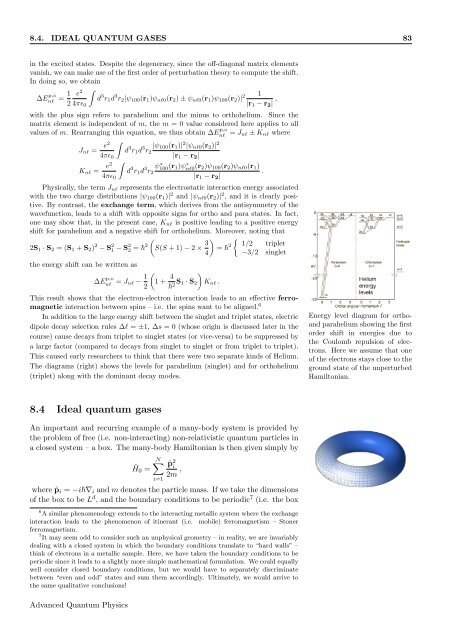Identical Particles - Theory of Condensed Matter
Identical Particles - Theory of Condensed Matter
Identical Particles - Theory of Condensed Matter
Create successful ePaper yourself
Turn your PDF publications into a flip-book with our unique Google optimized e-Paper software.
8.4. IDEAL QUANTUM GASES 83<br />
in the excited states. Despite the degeneracy, since the <strong>of</strong>f-diagonal matrix elements<br />
vanish, we can make use <strong>of</strong> the first order <strong>of</strong> perturbation theory to compute the shift.<br />
In doing so, we obtain<br />
∆E p,o<br />
nℓ<br />
1 e<br />
=<br />
2<br />
2 <br />
4πɛ0<br />
d 3 r1d 3 r2|ψ100(r1)ψnℓ0(r2) ± ψnℓ0(r1)ψ100(r2)| 2<br />
1<br />
|r1 − r2| ,<br />
with the plus sign refers to parahelium and the minus to orthohelium. Since the<br />
matrix element is independent <strong>of</strong> m, the m = 0 value considered here applies to all<br />
values <strong>of</strong> m. Rearranging this equation, we thus obtain ∆E p,o<br />
nℓ = Jnℓ ± Knℓ where<br />
Jnℓ = e2<br />
4πɛ0<br />
Knℓ = e2<br />
4πɛ0<br />
<br />
<br />
d 3 r1d 3 |ψ100(r1)|<br />
r2<br />
2 |ψnℓ0(r2)| 2<br />
|r1 − r2|<br />
d 3 r1d 3 ψ<br />
r2<br />
∗ 100(r1)ψ∗ nℓ0 (r2)ψ100(r2)ψnℓ0(r1)<br />
.<br />
|r1 − r2|<br />
Physically, the term Jnℓ represents the electrostatic interaction energy associated<br />
with the two charge distributions |ψ100(r1)| 2 and |ψnℓ0(r2)| 2 , and it is clearly positive.<br />
By contrast, the exchange term, which derives from the antisymmetry <strong>of</strong> the<br />
wavefunction, leads to a shift with opposite signs for ortho and para states. In fact,<br />
one may show that, in the present case, Knℓ is positive leading to a positive energy<br />
shift for parahelium and a negative shift for orthohelium. Moreover, noting that<br />
2S1 · S2 =(S1 + S2) 2 − S 2 1 − S 2 2 = 2<br />
<br />
S(S + 1) − 2 × 3<br />
<br />
= <br />
4<br />
2<br />
<br />
1/2 triplet<br />
−3/2 singlet<br />
the energy shift can be written as<br />
∆E p,o<br />
nℓ = Jnℓ − 1<br />
2<br />
<br />
1+ 4<br />
2 S1<br />
<br />
· S2 Knℓ .<br />
This result shows that the electron-electron interaction leads to an effective ferromagnetic<br />
interaction between spins – i.e. the spins want to be aligned. 6<br />
In addition to the large energy shift between the singlet and triplet states, electric<br />
dipole decay selection rules ∆ℓ = ±1, ∆s = 0 (whose origin is discussed later in the<br />
course) cause decays from triplet to singlet states (or vice-versa) to be suppressed by<br />
a large factor (compared to decays from singlet to singlet or from triplet to triplet).<br />
This caused early researchers to think that there were two separate kinds <strong>of</strong> Helium.<br />
The diagrams (right) shows the levels for parahelium (singlet) and for orthohelium<br />
(triplet) along with the dominant decay modes.<br />
8.4 Ideal quantum gases<br />
An important and recurring example <strong>of</strong> a many-body system is provided by<br />
the problem <strong>of</strong> free (i.e. non-interacting) non-relativistic quantum particles in<br />
a closed system – a box. The many-body Hamiltonian is then given simply by<br />
ˆH0 =<br />
N<br />
i=1<br />
ˆp 2 i<br />
2m ,<br />
where ˆpi = −i∇i and m denotes the particle mass. If we take the dimensions<br />
<strong>of</strong> the box to be L d , and the boundary conditions to be periodic 7 (i.e. the box<br />
6 A similar phenomenology extends to the interacting metallic system where the exchange<br />
interaction leads to the phenomenon <strong>of</strong> itinerant (i.e. mobile) ferromagnetism – Stoner<br />
ferromagnetism.<br />
7 It may seem odd to consider such an unphysical geometry – in reality, we are invariably<br />
dealing with a closed system in which the boundary conditions translate to “hard walls” –<br />
think <strong>of</strong> electrons in a metallic sample. Here, we have taken the boundary conditions to be<br />
periodic since it leads to a slightly more simple mathematical formulation. We could equally<br />
well consider closed boundary conditions, but we would have to separately discriminate<br />
between “even and odd” states and sum them accordingly. Ultimately, we would arrive to<br />
the same qualitative conclusions!<br />
Advanced Quantum Physics<br />
Energy level diagram for orthoand<br />
parahelium showing the first<br />
order shift in energies due to<br />
the Coulomb repulsion <strong>of</strong> electrons.<br />
Here we assume that one<br />
<strong>of</strong> the electrons stays close to the<br />
ground state <strong>of</strong> the unperturbed<br />
Hamiltonian.

















